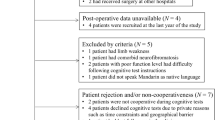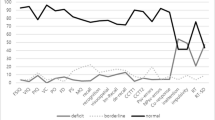Abstract
Purpose
To investigate the characteristics of patients with moyamoya disease (MMD) who show improvement in their cognitive decline after bypass surgery by analyzing the hemodynamic and metabolic parameters of 15O-gas positron emission tomography (PET).
Materials and methods
We retrospectively analyzed adult patients with MMD who were evaluated with PET and cognitive tests before and approximately one year after indirect bypass surgery. The PET parameters of the left Rolandic area were compared between patients who did and did not show improvement in their cognitive decline.
Results
Of the 19 patients analyzed, fourteen (74%) showed improvement in either the verbal or performance intelligence quotient (VIQ or PIQ). Three out of four patients with perioperative infarction experienced significant cognitive decline. The preoperative oxygen extraction fraction (OEF) was significantly higher in patients who showed improvement in their cognitive decline in terms of the PIQ than in those patients who did not (P = 0.03). The postoperative increase in the cerebral metabolic rate of oxygen (CMRO2) was significantly higher in patients who showed improvement in their cognitive decline in terms of the VIQ than in those who did not (P = 0.02).
Conclusion
Adult patients with MMD might show improvement in their cognitive decline after successful indirect bypass surgery if they have a severely increased regional OEF before the surgery and an increased regional CMRO2 after the surgery.
Clinical trial registration
URL: https://www.umin.ac.jp/ctr/. Unique identifier: UMIN000027949.





Similar content being viewed by others
References
Kuroda S, Houkin K. Moyamoya disease: current concepts and future perspectives. Lancet Neurol. 2008;7(11):1056–66.
Piao R, Oku N, Kitagawa K, Imaizumi M, Matsushita K, Yoshikawa T, et al. Cerebral hemodynamics and metabolism in adult moyamoya disease: comparison of angiographic collateral circulation. Ann Nucl Med. 2004;18(2):115.
Weinberg DG, Rahme RJ, Aoun SG, Batjer HH, Bendok BR. Moyamoya disease: functional and neurocognitive outcomes in the pediatric and adult populations. Neurosurg Focus. 2011;30(6):E21.
Festa JR, Schwarz LR, Pliskin N, Cullum CM, Lacritz L, Charbel FT, et al. Neurocognitive dysfunction in adult moyamoya disease. J Neurol. 2010;257(5):806–15.
Kazumata K, Tha KK, Narita H, Kusumi I, Shichinohe H, Ito M, et al. Chronic ischemia alters brain microstructural integrity and cognitive performance in adult moyamoya disease. Stroke. 2015;46(2):354–60.
Hara S, Hori M, Murata S, Ueda R, Tanaka Y, Inaji M, et al. Microstructural damage in normal-appearing brain parenchyma and neurocognitive dysfunction in adult moyamoya disease. Stroke. 2018;49:2504–7.
Hosoda C, Nariai T, Ishiwata K, Ishii K, Matsushima Y, Ohno K. Correlation between focal brain metabolism and higher brain function in patients with Moyamoya disease. Int J Stroke. 2010;5(5):367–73.
Zeifert PD, Karzmark P, Bell-Stephens TE, Steinberg GK, Dorfman LJ. Neurocognitive performance after cerebral revascularization in adult moyamoya disease. Stroke. 2017;48(6):1514–7.
Lee JY, Phi JH, Wang KC, Cho BK, Shin MS, Kim SK. Neurocognitive profiles of children with moyamoya disease before and after surgical intervention. Cerebrovasc Dis. 2011;31(3):230–7.
Wityk RJ, Hillis A, Beauchamp N, Barker PB, Rigamonti D. Perfusion-weighted magnetic resonance imaging in adult moyamoya syndrome: characteristic patterns and change after surgical intervention: case report. Neurosurgery. 2002;51(6):1499–506.
Kazumata K, Tha KK, Tokairin K, Ito M, Uchino H, Kawabori M, et al. Brain structure, connectivity, and cognitive changes following revascularization surgery in adult moyamoya disease. Neurosurgery. 2019
Guidelines for diagnosis and treatment of moyamoya disease (spontaneous occlusion of the circle of Willis). Neurol Med Chir (Tokyo) 2012;52(5):245–66.
Matsushima Y, Fukai N, Tanaka K, Tsuruoka S, Inaba Y, Aoyagi M, et al. A new surgical treatment of moyamoya disease in children: a preliminary report. Surg Neurol. 1981;15(4):313–20.
Aoyagi M, Tanaka Y, Tamura K, Maehara T, Nariai T, Ohno K. Vasculrrized flap with multiple small dural opening in patients with Moyamoya disease with hemodynamic impariments in the posterior circulation. Video J Neurosurg. 2007;15(4).
Nariai T. Treatment of moyamoya disease using indirect bypass surgery. In: Saito N, editor. Prime neurosurgery 2. Miwa: Cerebral Ischemia; 2017. p. 81–87.
Nariai T, Suzuki R, Matsushima Y, Ichimura K, Hirakawa K, Ishii K, et al. Surgically induced angiogenesis to compensate for hemodynamic cerebral ischemia. Stroke. 1994;25(5):1014–21.
Hara S, Tanaka Y, Ueda Y, Hayashi S, Inaji M, Ishiwata K, et al. Noninvasive evaluation of CBF and perfusion delay of moyamoya disease using arterial spin-labeling MRI with multiple postlabeling delays: comparison with 15O-gas PET and DSC-MRI. AJNR Am J Neuroradiol. 2017;38(4):696–702.
Ishii Y, Tanaka Y, Momose T, Yamashina M, Sato A, Wakabayashi S, et al. Chronologic evaluation of cerebral hemodynamics by dynamic susceptibility contrast magnetic resonance imaging after indirect bypass surgery for moyamoya disease. World Neurosurg. 2017;108:427–35.
Hosoda C, Nariai T, Kawasaki K, Ishiwata K, Ishii K, Inaji M, et al. Altered correlation between intelligence quotient and PET measured cerebral metabolism induced by surgical revascularization in patients with Moyamoya disease, In: Abstracts of the 13th Annual Meeting of the Organization for Human Brain Mapping (2007). Neuroimage. 2007;36(Supplement 1):e1.
Fujita K, Maekawa H, Dairoku H, Yamanaka K. Assessment cases and clinical researches using Japanese version of WAIS-III: Nihon Bunka Kagakusha; 2011. iv, 278 pp.
Dairoku H. Secular change in: Assesment case series using WISC-III: theory and practice. Kazuhiro F, Kazuhiko U, Hisao M, Toshiyuki I, Hitoshi D, editors: Nihon Bunka Kagakusya; 2005. v, 362 pp.
Senda M, Buxton RB, Alpert NM, Correia JA, Mackay BC, Weise SB, et al. The 15O steady-state method: correction for variation in arterial concentration. J Cereb Blood Flow Metab. 1988;8(5):681–90.
Sadato N, Yonekura Y, Senda M, Iwasaki Y, Matoba N, Tamaki N, et al. PET and the autoradiographic method with continuous inhalation of oxygen-15-gas: theoretical analysis and comparison with conventional steady-state methods. J Nucl Med. 1993;34(10):1672–80.
Iida H, Kanno I, Miura S, Murakami M, Takahashi K, Uemura K. Error analysis of a quantitative cerebral blood flow measurement using H2(15)O autoradiography and positron emission tomography, with respect to the dispersion of the input function. J Cereb Blood Flow Metab. 1986;6:536–45.
Lammertsma AA, Jones T. Correction for the presence of intravascular oxygen-15 in the steady-state technique for measuring regional oxygen extraction ratio in the brain: 1. Description of the method. J Cereb Blood Flow Metab. 1983;3(4):416–24.
Mintun MA, Raichle ME, Martin WR, Herscovitch P. Brain oxygen utilization measured with O-15 radiotracers and positron emission tomography. J Nucl Med. 1984;25(2):177–87.
Nariai T, Matsushima Y, Imae S, Tanaka Y, Ishii K, Senda M, et al. Severe haemodynamic stress in selected subtypes of patients with moyamoya disease: a positron emission tomography study. J Neurol Neurosurg Psychiatry. 2005;76(5):663–9.
Tanaka Y, Nariai T, Nagaoka T, Akimoto H, Ishiwata K, Ishii K, et al. Quantitative evaluation of cerebral hemodynamics in patients with moyamoya disease by dynamic susceptibility contrast magnetic resonance imaging–comparison with positron emission tomography. J Cereb Blood Flow Metab. 2006;26(2):291–300.
Baek HJ, Chung SY, Park MS, Kim SM, Park KS, Son HU. Preliminary study of neurocognitive dysfunction in adult moyamoya disease and improvement after superficial temporal artery-middle cerebral artery bypass. J Korean Neurosurg Soc. 2014;56(3):188–93.
Yanagihara W, Chida K, Kobayashi M, Kubo Y, Yoshida K, Terasaki K, et al. Impact of cerebral blood flow changes due to arterial bypass surgery on cognitive function in adult patients with symptomatic ischemic moyamoya disease. J Neurosurg. 2018:1–9.
Karzmark P, Zeifert PD, Bell-Stephens TE, Steinberg GK, Dorfman LJ. Neurocognitive impairment in adults with moyamoya disease without stroke. Neurosurgery. 2012;70(3):634–8.
Karzmark P, Zeifert PD, Tan S, Dorfman LJ, Bell-Stephens TE, Steinberg GK. Effect of moyamoya disease on neuropsychological functioning in adults. Neurosurgery. 2008;62(5):1048–51.
Calviere L, Yan Kai G, Catalaa I, Marlats F, Bonneville F, Larrue V. Executive dysfunction in adults with moyamoya disease is associated with increased diffusion in frontal white matter. J Neurol Neurosurg Psychiatry. 2012;83(6):591–3.
Kazumata K, Tha KK, Uchino H, Ito M, Nakayama N, Abumiya T. Mapping altered brain connectivity and its clinical associations in adult moyamoya disease: a resting-state functional MRI study. PLoS ONE. 2017;12(8):e0182759.
Powers WJ. Cerebral hemodynamics in ischemic cerebrovascular disease. Ann Neurol. 1991;29(3):231–40.
Fujimura M, Mugikura S, Kaneta T, Shimizu H, Tominaga T. Incidence and risk factors for symptomatic cerebral hyperperfusion after superficial temporal artery-middle cerebral artery anastomosis in patients with moyamoya disease. Surg Neurol. 2009;71(4):442–7.
Kazumata K, Tha KK, Uchino H, Shiga T, Shichinohe H, Ito M, et al. Topographic changes in cerebral blood flow and reduced white matter integrity in the first 2 weeks following revascularization surgery in adult moyamoya disease. J Neurosurg. 2017;127(2):260–9.
Nanba T, Ogasawara K, Nishimoto H, Fujiwara S, Kuroda H, Sasaki M, et al. Postoperative cerebral white matter damage associated with cerebral hyperperfusion and cognitive impairment after carotid endarterectomy: a diffusion tensor magnetic resonance imaging study. Cerebrovasc Dis. 2012;34(5–6):358–67.
Leblanc R, Tyler JL, Mohr G, Meyer E, Diksic M, Yamamoto L, et al. Hemodynamic and metabolic effects of cerebral revascularization. J Neurosurg. 1987;66(4):529–35.
Hara S, Hori M, Ueda R, Hayashi S, Inaji M, Tanaka Y, et al. Unraveling specific brain microstructural damage in moyamoya disease using diffusion magnetic resonance imaging and positron emission tomography. J Stroke Cerebrovasc Dis. 2019;28(4):1113–25.
Acknowledgments
This work was supported by Grant-in-Aid for Scientific Research “KAKENHI”, Japan Society for the Promotion of Science (Grant no. 26305031).
Funding
Grant-in-Aid for Scientific Research “KAKENHI”, Japan Society for the Promotion of Science (Grant no. 26305031) given to Tadashi Nariai.
Author information
Authors and Affiliations
Corresponding author
Ethics declarations
Conflict of interest
No potential conflicts of interest were disclosed.
Additional information
Publisher's Note
Springer Nature remains neutral with regard to jurisdictional claims in published maps and institutional affiliations.
Electronic supplementary material
Below is the link to the electronic supplementary material.
Rights and permissions
About this article
Cite this article
Hara, S., Kudo, T., Hayashi, S. et al. Improvement in cognitive decline after indirect bypass surgery in adult moyamoya disease: implication of 15O-gas positron emission tomography. Ann Nucl Med 34, 467–475 (2020). https://doi.org/10.1007/s12149-020-01473-8
Received:
Accepted:
Published:
Issue Date:
DOI: https://doi.org/10.1007/s12149-020-01473-8




